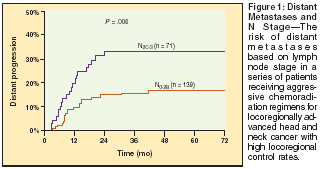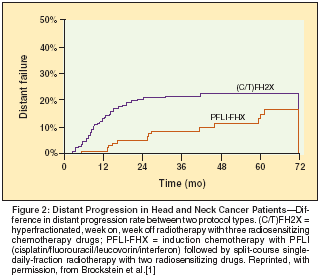Commentary (Brockstein/Vokes): Revisiting Induction Chemotherapy for Head and Neck Cancer
Argiris et al present a comprehensivereview of inductionchemotherapy for head andneck cancer, and should be lauded fortheir meticulous work. This papercarefully delineates and categorizesmost of the relevant induction chemotherapystudies in head and neckcancer performed over the past 3 decades.The authors have sought to answerquestions regarding the optimalnumber of chemotherapy cycles (acritical factor when one uses responseto induction chemotherapy to determineeligibility for organ preservationor in an attempt to enhance curerates), the optimal chemotherapyregimen, and the possibility of a sitespecificbenefit to induction chemotherapy.The paper assesses benefitbased on treatment intent-that is, organpreservation vs survival benefit.Importantly, by excavating the layersof the past, the authors provide aframework with which to construct anew paradigm of treatment for headand neck cancer that may again incorporateinduction chemotherapy.
Argiris et al present a comprehensive review of induction chemotherapy for head and neck cancer, and should be lauded for their meticulous work. This paper carefully delineates and categorizes most of the relevant induction chemotherapy studies in head and neck cancer performed over the past 3 decades. The authors have sought to answer questions regarding the optimal number of chemotherapy cycles (a critical factor when one uses response to induction chemotherapy to determine eligibility for organ preservation or in an attempt to enhance cure rates), the optimal chemotherapy regimen, and the possibility of a sitespecific benefit to induction chemotherapy. The paper assesses benefit based on treatment intent-that is, organ preservation vs survival benefit. Importantly, by excavating the layers of the past, the authors provide a framework with which to construct a new paradigm of treatment for head and neck cancer that may again incorporate induction chemotherapy. What We Know
What is established about induction chemotherapy? Such treatment has proven to be beneficial in affording organ preservation, in particular in the larynx and hypopharynx. As pointed out, however, concomitant chemoradiation (CRT) is a superior method of organ preservation, at least for larynx cancer. The treatment course is shorter and the long-term side effects are no greater than with induction chemotherapy, although in-field short-term toxicities are greater with CRT. We also know that effects on survival have generally not been statistically significant in most randomized trials and that local control is not increased. As pointed out by Argiris et al, there have been at least one and possibly two large, well-conducted positive studies of induction chemotherapy, but the vast majority have been negative. Even accounting for the small reduction in risk of death with the specific drug combination of cisplatin and fluorouracil (5-FU) as pointed out in the Meta-Analysis of Chemotherapy on Head and Neck Cancer (MACH-NC), one does not achieve the magnitude of benefit of CRT demonstrated by either the MACH-NC meta-analysis or a number of randomized studies of CRT that have been performed over the past decade. Induction chemotherapy, however, remains a fertile setting for exploring the efficacy of chemotherapy drugs and regimens, as has been the case with regimens such as TPF (docetaxel [Taxotere], cisplatin [Platinol], 5-FU) and TPFL (TPF plus leucovorin). A theoretical benefit not well quantified to date is that induction chemotherapy may improve a patient's performance status, tumorrelated symptoms, and weight prior to intensive definitive therapy, and may help to allow patients to avoid gastric feeding tubes by optimally preparing them for CRT or surgery. These theoretical benefits are being actively explored. Survival Benefit?
So why continue to attempt to resurrect induction chemotherapy? The answer lies in the ability to "induce" something (such as an improvement in survival by decreasing distant metastases), and to predict those for whom an induction is needed (patient subsets who benefit from induction chemotherapy). Traditionally, squamous cell head and neck cancer patients have died from locoregional recurrence and have not lived long enough to manifest metastatic disease. Because high locoregional relapse rates lead to short survival times, the benefit of reduction in distant metastases demonstrated in several studies was of little value in reducing head and neck cancer deaths, which occurred locoregionally. Data from our group predict that when locoregional control rates are high, patients with N2 or N3 disease will be more likely to develop distant metastases than locoregional recurrence (Figures 1 and 2).[1] Distant failure occurs in approximately 30% to 40% of these advanced-stage patients with positive lymph nodes. A one-quarter to one-third reduction in the rate of distant metastases, the risk reduction realized in several studies of induction 5-FU and cisplatin,[2] could then turn into a measurable 5% to 15% reduction in death-perhaps higher if the induction chemotherapy regimen contributes to locoregional control. Importantly, one could only expect to see this survival benefit if locoregional disease is controlled. More recently, a number of studies (Table 6 in the article by Argiris et al) have examined the combination of induction chemotherapy followed sequentially by CRT. It is from these studies that hypotheses supporting induction chemotherapy can be derived.


Multicenter Studies
Our multi-institutional group performed a series of five studies involving 337 locoregionally advanced stage IV patients between 1989 and 1998.[1] In the first two studies, an intensive and effective induction chemotherapy regimen, PFLI (cisplatin, 5-FU, leucovorin, and interferon) preceded split-course once-daily radiotherapy (RT) plus concomitant 5-FU and hydroxyurea. In the last three studies, induction chemotherapy was eliminated, and locoregional therapy was intensified with hyperfractionated split-course RT plus concomitant chemotherapy. A striking and statistically significant reversal of failure patterns was seen in this retrospective analysis of well-balanced patients from prospective studies (Figures 2 and 3).[1] The actuarial 5-year rates of locoregional recurrence in the induction, conventionally fractionated RT arm and no induction, hyperfractionated RT arm were 31% and 17%, respectively, whereas distant recurrence rates were 13% vs 22%.[1]

Based on these results, two studies were performed by our group from 1998 to 2001 sequencing induction che motherapy (carboplatin and paclitaxel) followed by split-course hyperfractionated CRT (TFHX) in stage IV locoregionally advanced head and neck cancer.[3,4] In the initial analysis of both studies, 2- and 3-year rates of locoregional and distant control were both greater than 90%, and the 3-year overall survival rate was 70%. High rates of both locoregional and distant control with survival higher than historically expected have been reported from other studies listed in Table 6 of the Argiris et al article. This is compatible with but not proof of the hypothesis of reduction in the rate of distant metastases with induction chemotherapy. Conclusions
Before we can resurrect induction chemotherapy as a standard component of the nonoperative curativeintent therapy for locoregionally advanced head and neck cancer, prospective randomized trials will need to be conducted. These trials will need to confirm the hypothesis that induction chemotherapy improves survival or other important end points such as nonlaryngeal organ preservation, or quality of life during or after chemoradiation. The first of these trials to get under way, headed by the University of Chicago, has just begun accrual. All patients will receive DFHX (docetaxel, 5-FU, hydroxyurea, and split-course hyperfractionated CRT). Half of patients will be randomized to additionally receive docetaxel, cisplatin, and 5-FU induction chemotherapy for two cycles. The accrual goal of 400 patients will come from 20 participating institutions.
Disclosures:
The authors have no significant financial interest or other relationship with the manufacturers of any products or providers of any service mentioned in this article.
References:
1. Brockstein B, Haraf DJ, Rademaker AW, et al: Patterns of failure, prognostic factors, and survival in locoregionally head and neck cancer treated with concomitant chemoradiotherapy: A 9-year, 337 patient, multi-institutional experience. Ann Oncol 15:1179-1186, 2004.
2. Brockstein B, Vokes EE: Chemoradiotherapy for head and neck cancer. PPO Updates 10:1-19, 1996.
3. Vokes EE, Stenson K, Rosen F, et al: Weekly carboplatin and paclitaxel followed by concomitant paclitaxel, fluorouracil, and hydroxyurea chemoradiotherapy: Curative and organ preserving therapy for advanced head and neck cancer. J Clin Oncol 21:320-326, 2003.
4. Haraf DJ, Rosen FR, Stenson K, et al: Induction chemotherapy followed by concomitant TFHX chemoradiotherapy with reduced dose radiation in advanced head and neck cancer. Clin Cancer Res 9:5936-5943, 2003.